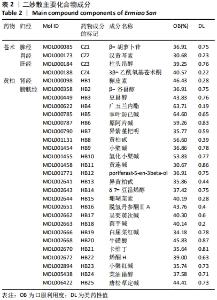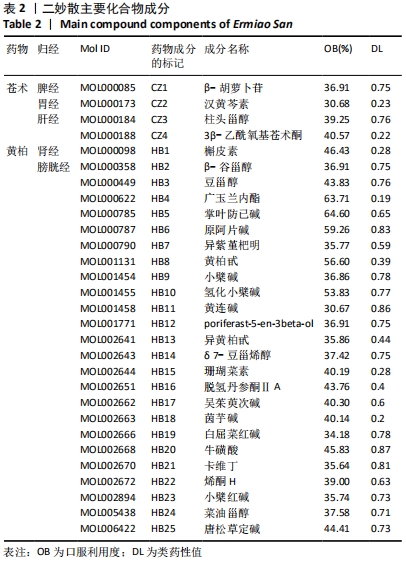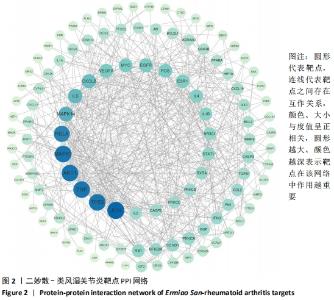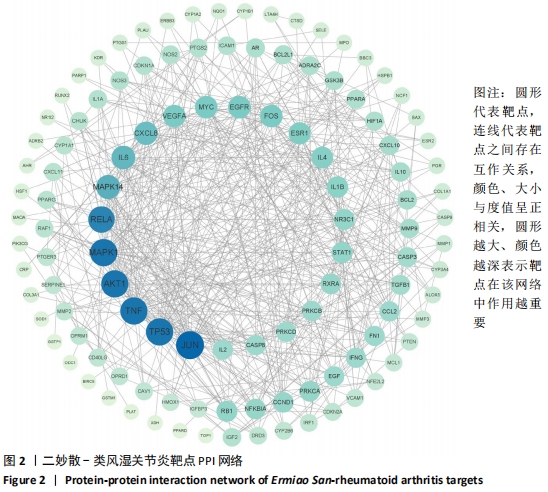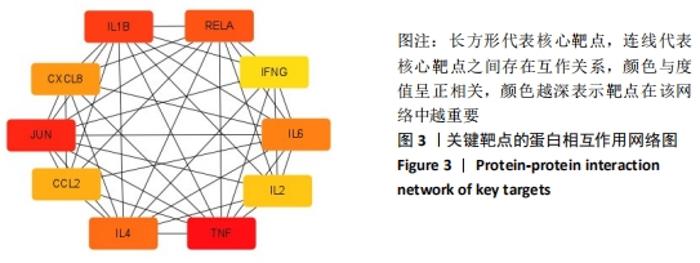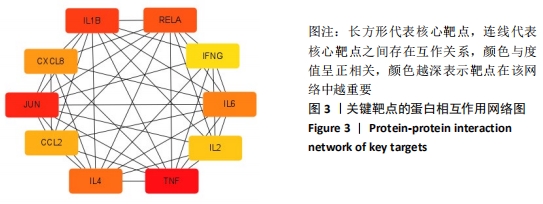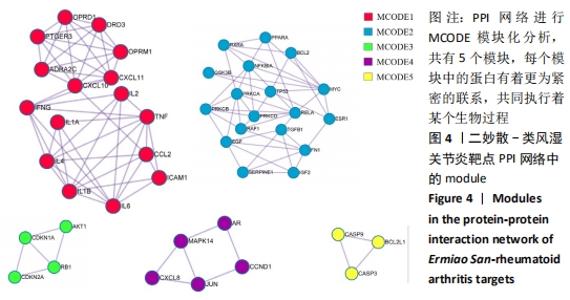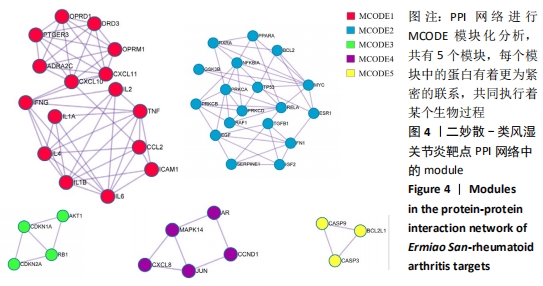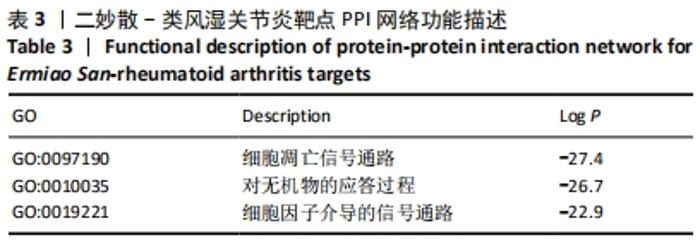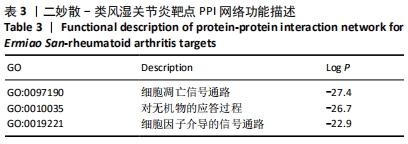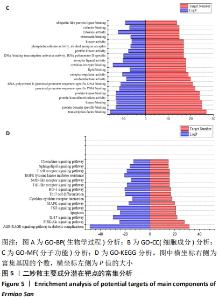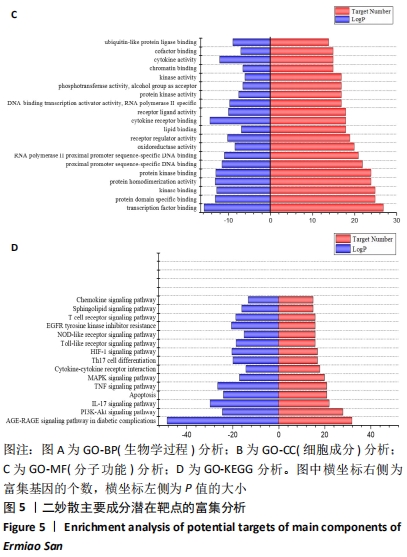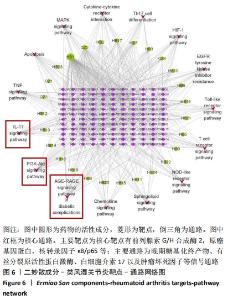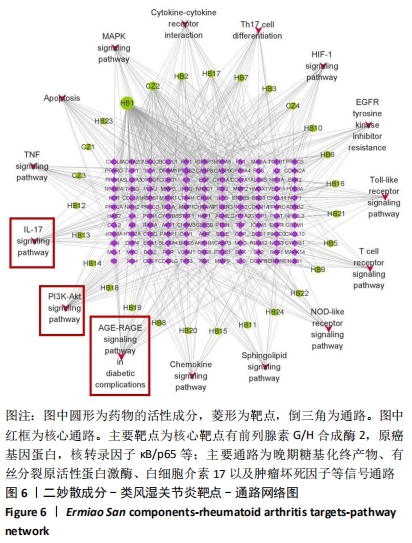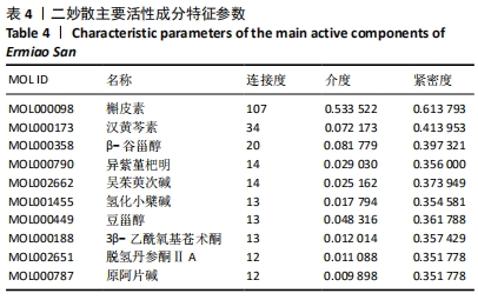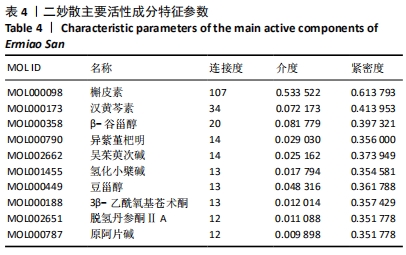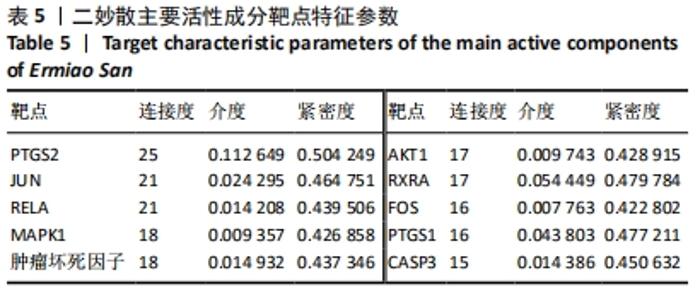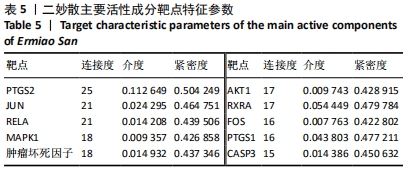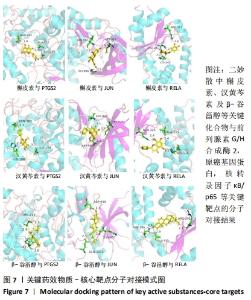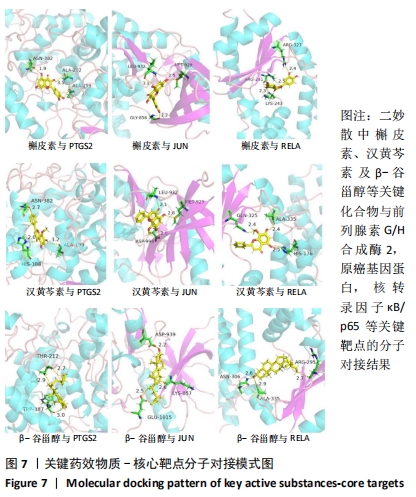Chinese Journal of Tissue Engineering Research ›› 2022, Vol. 26 ›› Issue (5): 742-748.doi: 10.12307/2022.121
Previous Articles Next Articles
Mechanism of Ermiao San in the treatment of rheumatoid arthritis
Zhao Yuwei1, Gao Yuting2, Li Zhen1, 2, Hao Huiqin1, 2
- 1Basic Medical College, 2Basic Laboratory of Integrated Traditional Chinese and Western Medicine, Shanxi University of Chinese Medicine, Jinzhong 030600, Shanxi Province, China
-
Received:2020-11-10Revised:2020-11-13Accepted:2020-12-14Online:2022-02-18Published:2021-12-01 -
Contact:Hao Huiqin, MD, Professor, Basic Medical College, Basic Laboratory of Integrated Traditional Chinese and Western Medicine, Shanxi University of Chinese Medicine, Jinzhong 030600, Shanxi Province, China -
About author:Zhao Yuwei, MD, Lecturer, Basic Medical College, Shanxi University of Chinese Medicine, Jinzhong 030600, Shanxi Province, China -
Supported by:the National Natural Science Foundation of China, No. 81904034 (to LZ); Shanxi Provincial Key Research and Development Program, No. 201803D31084 (to HHQ); General Youth Fund Project of Shanxi Province, No. 201901D211534 (to GYT)
CLC Number:
Cite this article
Zhao Yuwei, Gao Yuting, Li Zhen, Hao Huiqin . Mechanism of Ermiao San in the treatment of rheumatoid arthritis[J]. Chinese Journal of Tissue Engineering Research, 2022, 26(5): 742-748.
share this article
Add to citation manager EndNote|Reference Manager|ProCite|BibTeX|RefWorks

2.2 类风湿关节炎相关靶点的获取 从 Genecards数据库获得类风湿关节炎靶点4 329个。根据经验设定Score值大于中位数的目标靶点为类风湿关节炎的潜在靶点。GeneCards 数据库中,类风湿关节炎靶点Score值最大值为114.78,最小值为0.23,中位数为1.82,因此Score > 1.82的靶点为类风湿关节炎的潜在靶点。然后,结合其他数据库进行补充,最终预测了2 247个类风湿关节炎相关靶点。 2.3 二妙散成分-类风湿关节炎靶点-通路网络的构建 将预测的二妙散药物靶点与类风湿关节炎疾病靶点取交集,并通过Venny绘制韦恩图,得到二妙散成分-类风湿关节炎共同靶点132 个,见图1。将这132个靶点录入STRING,获得了PPI网络,并导入Cytoscape软件绘制蛋白关系PPI网络图,见图2。该网络包括132个节点,共524条边。节点的大小、颜色与此节点的Degree值成正比,即节点越大、颜色越深对应蛋白的Degree值越大。使用插件CytoHubba计算出得分较高的关键作用靶点,见图3,包括肿瘤坏死因子、JUN、白细胞介素1B、RELA、白细胞介素4、白细胞介素6、CXCL8、CCL2、白细胞介素2和IFNG,这些靶点在蛋白网络中具有枢纽的重要地位,在二妙散治疗类风湿关节炎中具有重要意义,可作为其有效成分作用的靶点。"

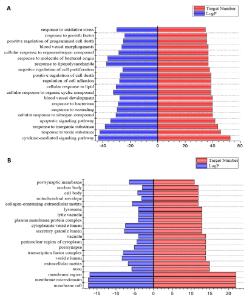
2.4 靶点功能与通路的富集分析 文章采用 Metascape平台对二妙散治疗类风湿关节炎相关靶点进行信号通路分析,并使用 Origin Lab 9.1软件绘图。二妙散主要参与的生物学过程包括生物对有毒物质的应答过程(response to toxic substance)、对无机物的应答过程(response to inorganic substance)、对脂多糖的应答过程(response to lipopolysaccharide)、对细菌源分子的应答过程(response to molecule of bacterial origin),细胞因子介导的信号通路(cytokine-mediated signaling pathway),细胞凋亡信号通路(apoptotic signaling pathway),见图5A,参与的通路主要有AGE-RAGE信号通路、MAPK信号通路、白细胞介素17信号通路以及肿瘤坏死因子信号通路等,见图5D。 相关靶点调节类风湿关节炎的功能主要富集于转录因子结合(transcription factor binding),蛋白域特异结合(protein domain specific binding),近端启动子序列特异性DNA结合(proximal promoter sequence-specific DNA binding),RNA聚合酶Ⅱ特异性(DNA-binding transcription activator activity,RNA polymerase Ⅱ-specific),RNA聚合酶Ⅱ近端启动子序列特异性DNA结合(RNA polymerase Ⅱ proximal promoter sequence-specific DNA binding),DNA结合转录激活物活性,染色质结合(chromatin binding)等,见图5C。"
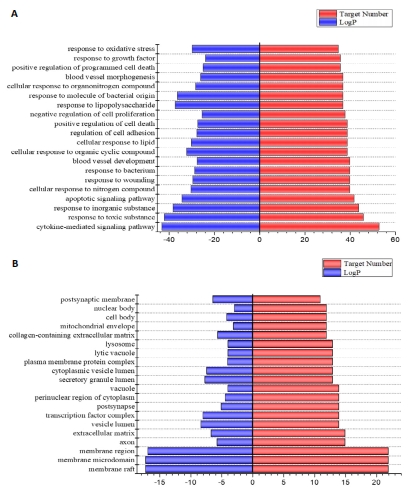
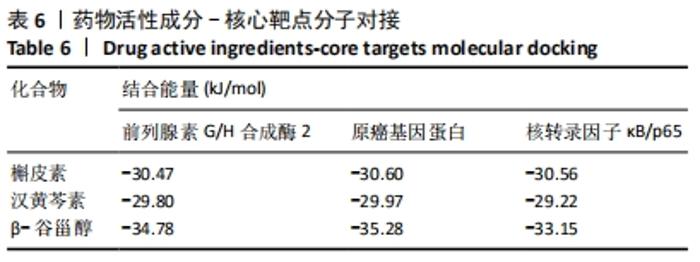
2.6 成分-靶点分子对接验证分析结果 文章选取二妙散活性成分中Degree值排名前3的关键药效物质与核心靶点进行分子对接验证发现,关键药效物质与核心靶点结合活性均较好,见表6。将上述对接结果利用Pymol软件绘图,由图可知,槲皮素与 PTGS2在ASN-382,ALA-202,ALA-199处形成氢键,与JUN在LEU-932,MET-929,GLY-856处形成氢键,与RELA在ARG-327,ARG-241,LYS-243处形成氢键;汉黄芩素与PTGS2在ASN-382,ALA-199和HIS-388处形成氢键,与JUN在LEU-932,MET-929,ASP-994处形成氢键,与RELA在GLN-325,ALA-335和HIS-176处形成氢键;β-谷甾醇与PTGS2在THR-212和TRP-387处形成氢键,与JUN在ASP-939,LYS-857和GLU-1015处形成氢键,与RELA在ASN-306,ALA-335和ARG-295处形成氢键,见图7。"
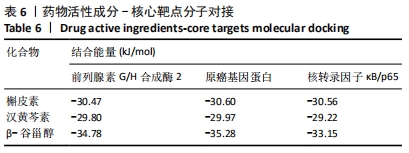
| [1] SHARIF K, SHARIF A, JUMAH F, et al. Rheumatoid arthritis in review: clinical, anatomical, cellular and molecular points of view. Clin Anat. 2018;31(2):216-223. [2] 陈劲松,王中汉,常非,等.多种特殊状态下关节软骨缺损修复的组织工程技术[J].中国组织工程研究,2020,24(8):1272-1279. [3] 张勇,温蕾.中医对风湿性关节炎的病因病机认识及治疗现状研究[J].中医临床研究,2018,10(35):144-146. [4] 但文超,何庆勇,曲艺,等.基于网络药理学的枳术丸调治血脂异常的分子机制研究[J].世界科学技术-中医药现代化, 2019,21(11):2396-2405. [5] 危亦林(元).世医得效方[M].北京:中国中医药出版社,1996:136. [6] 朱震亨(元).丹溪心法[M].沈阳:辽宁科学技术出版社,1997:72. [7] 张云程.二妙散加味治疗痹症[J].四川中医,1983(2):35. [8] 谢莉,黄志鹏.二妙散合宣痹汤加减治疗类风湿关节炎(活动期)临床疗效观察[J].心理月刊,2020,15(14):200. [9] 王泽,高玉亭,李振,等.二妙散对CIA大鼠关节NF-κBp50和ERK1/2表达特性的影响[J].中国免疫学杂志,2020,36(16):1951-1956. [10] 董培良,李慧,韩华.中药网络药理学的应用与思考[J].中国实验方剂学杂志, 2020,26(17):204-211. [11] 贺红安,王晓,陈雅桐,等.基于网络药理学和分子对接探讨升降散治疗儿童慢性扁桃体炎的作用机制[J/OL].中国中药杂志: 1-10. https://kns.cnki.net/kcms/detail/detail. [12] ZHOU Y, ZHOU B, PACHE L, et al. Metascape provides a biologist-oriented resource for the analysis of systems-level datasets. Nat Commun. 2019;10(1):1523. [13] VELLA D, MARINI S, VITALI F, et al. MTGO: PPI network analysis via topological and functional module identification . Sci Rep. 2018;8(1):5499. [14] SMOLEN JS, ALETAHA D, MCINNES IB. Rheumatoid arthritis. Lancet. 2016;388 (10055):2023-2038. [15] SCOTT DL, WOLFE F, HUIZINGA TW. Rheumatoid arthritis. Lancet. 2010;376(9746): 1094-1108. [16] ALLARD-CHAMARD H, BOIRE G. Serologic diagnosis of rheumatoid arthritis. Clin Lab Med. 2019;39(4):525-537. [17] GIANNINI D, ANTONUCCI M, PETRELLI F, et al. One year in review 2020: pathogenesis of rheumatoid arthritis. Clin Exp Rheumatol. 2020;38(3):387-397. [18] 赵璐, 何东仪. 类风湿关节炎病因病机及辨证论治[J].风湿病与关节炎, 2016,5(7):71-74. [19] 林昌松,李楠,姜玉宝,等.类风湿关节炎的中西医结合治疗研究进展[J].中华中医药杂志,2017,32(11):5020-5023. [20] KIM HR, KIM BM, WON JY, et al. Quercetin, a plant polyphenol, has potential for the prevention of bone destruction in rheumatoid arthritis. J Med Food. 2019;22(2):152-161. [21] HALEAGRAHARA N, MIRANDA-HERNANDEZ S, ALIM MA, et al. Therapeutic effect of quercetin in collagen-induced arthritis. Biomed Pharmacother. 2017;90:38-46. [22] SACKS D, BAXTER B, CAMPBELL BCV, et al. Multisociety consensus quality improvement revised consensus statement for endovascular therapy of acute ischemic stroke. Int J Stroke. 2018;13(6):612-632. [23] HUANG Y, GUO L, CHITTI R, et al. Wogonin ameliorate complete Freund’s adjuvant induced rheumatoid arthritis via targeting NF-κB/MAPK signaling pathway. Biofactors. 2020;46(2):283-291. [24] LIU R, HAO D, XU W, et al. β-Sitosterol modulates macrophage polarization and attenuates rheumatoid inflammation in mice. Pharm Biol. 2019;57(1):161-168. [25] DA FONSECA LJS, NUNES-SOUZA V, GOULART MOF, et al. Oxidative stress in rheumatoid arthritis: what the future might hold regarding novel biomarkers and add-on therapies. Oxid Med Cell Longev. 2019;2019:7536805. [26] WEI Q, LV F, ZHANG H, et al. MicroRNA-101-3p inhibits fibroblast-like synoviocyte proliferation and inflammation in rheumatoid arthritis by targeting PTGS2. Biosci Rep. 2020;40(1):BSR20191136. [27] HANNEMANN N, CAO S, ERIKSSON D, et al. Transcription factor Fra-1 targets arginase-1 to enhance macrophage-mediated inflammation in arthritis. J Clin Invest. 2019;129(7):2669-2684. [28] SABIR JSM, EL OMRI A, BANAGANAPALLI B, et al. Dissecting the role of NF-κb protein family and its regulators in rheumatoid arthritis using weighted gene co-expression network. Front Genet. 2019;10:1163. [29] PRASAD K. AGE-RAGE stress play a role in aortic aneurysm: a comprehensive review and novel potential therapeutic target. Rev Cardiovasc Med. 2019;20(4):201-208. [30] 郭锦晨,刘健,万磊,等.氧化应激及炎症反应在类风湿关节炎中的研究进展[J].风湿病与关节炎,2016,5(9):68-71, 76. [31] NOORT AR, TAK PP, TAS SW. Non-canonical NF-κB signaling in rheumatoid arthritis: Dr Jekyll and Mr Hyde. Arthritis Res Ther. 2015;17(1):15. |
| [1] | Zhang Lichuang, Xu Hao, Ma Yinghui, Xiong Mengting, Han Haihui, Bao Jiamin, Zhai Weitao, Liang Qianqian. Mechanism and prospects of regulating lymphatic reflux function in the treatment of rheumatoid arthritis [J]. Chinese Journal of Tissue Engineering Research, 2022, 26(9): 1459-1466. |
| [2] | Jing Jinpeng, Zhang Yue, Liu Xiaomin, Liu Yi. Traditional Chinese medicine injection for promoting blood circulation in prevention of deep vein thrombosis after orthopedic surgery: network meta-analysis [J]. Chinese Journal of Tissue Engineering Research, 2022, 26(9): 1467-1476. |
| [3] | Tang Wenjing, Wu Siyuan, Yang Chen, Tao Xi. Inflammatory responses in post-stroke depression [J]. Chinese Journal of Tissue Engineering Research, 2022, 26(8): 1278-1285. |
| [4] | Hui Xiaoshan, Bai Jing, Zhou Siyuan, Wang Jie, Zhang Jinsheng, He Qingyong, Meng Peipei. Theoretical mechanism of traditional Chinese medicine theory on stem cell induced differentiation [J]. Chinese Journal of Tissue Engineering Research, 2022, 26(7): 1125-1129. |
| [5] | Liu Jin, Li Zhen, Hao Huiqin, Wang Ze, Zhao Caihong, Lu Wenjing. Ermiao san aqueous extract regulates proliferation, migration, and inflammatory factor expression of fibroblast-like synovial cells in collagen-induced arthritis rats [J]. Chinese Journal of Tissue Engineering Research, 2022, 26(5): 688-693. |
| [6] | Li Anan, Jiang Tao, Zhan Min, Cai Yuning, Song Min, Li Congcong, Lin Wenzheng, Zhang Jiayuan, Liu Wengang. Pharmacological mechanism of Shenling Baizhu San in the treatment of knee osteoarthritis based on network pharmacology and molecular docking [J]. Chinese Journal of Tissue Engineering Research, 2022, 26(2): 197-204. |
| [7] | Zhang Xiaoyun, Li Huanan, Chen Feng, Chai Yuan, Gan Bin, Li Song, Chen Dingpeng. Potential molecular mechanism of Guizhi Shaoyao Zhimu Decoction in the treatment of gouty arthritis based on network pharmacology and molecular docking [J]. Chinese Journal of Tissue Engineering Research, 2022, 26(2): 245-252. |
| [8] | Li Chuanhong, Yu Xing, Yang Yongdong, Zhao He. Microglia in spinal cord injury: M1/M2 phenotypic polarization and neurotoxic/neuroprotective effects [J]. Chinese Journal of Tissue Engineering Research, 2022, 26(14): 2265-2272. |
| [9] | Chen Na, Fan Feiyan, Li Shuangli, Zhang Yunke. Effect and mechanism of traditional Chinese medicine regulating mesenchymal stem cell-derived exocrine for ischemic stroke [J]. Chinese Journal of Tissue Engineering Research, 2022, 26(13): 2081-2086. |
| [10] | Tang Yeling, Liang Pengchen, Shi Junfeng, Sun Miaomiao, Zhou Ziyan, Zhu Lisha, Li Tian, Liang Dongyu, Sha Shuang, Yi Qingqing, Chang Qing. Exploring effective components of Guyuling capsule in the treatment of osteoporosis based on bioinformatics analysis [J]. Chinese Journal of Tissue Engineering Research, 2022, 26(12): 1899-1906. |
| [11] | Xu Lin, Qi Hongshun, Ge Rucun, Li Peipei, Zhen Lixiao, Feng Xiaoya. Effects of minimally invasive surgery combined with metformin on inflammatory responses in rabbits with intracerebral hemorrhage [J]. Chinese Journal of Tissue Engineering Research, 2022, 26(11): 1741-1746. |
| [12] | Jiang Shengyuan, Deng Bowen, Xu Lin, Liu Gang, He Feng, Zhao Yi, Ren Jingpei, Mu Xiaohong. Role and mechanism of tetramethylpyrazine in spinal cord injury repair [J]. Chinese Journal of Tissue Engineering Research, 2022, 26(11): 1799-1804. |
| [13] | Liang Pengchen, Shi Junfeng, Sun Miaomiao, Liang Dongyu, Sha Shuang, Yi Qingqing, Chang Qing. Polydopamine assisted salidroside to improve bone formation on micro-arc oxidation of pure titanium [J]. Chinese Journal of Tissue Engineering Research, 2022, 26(10): 1522-1529. |
| [14] | An Yang, Liao Yinan, Xie Chengxin, Li Qinglong, Huang Ge, Jin Xin, Yin Dong. Mechanism of Inulae flos in the treatment of osteoporosis: an analysis based on network pharmacology [J]. Chinese Journal of Tissue Engineering Research, 2021, 25(在线): 1-8. |
| [15] | Yuan Jiawei, Zhang Haitao, Jie Ke, Cao Houran, Zeng Yirong. Underlying targets and mechanism of Taohong Siwu Decoction in prosthetic joint infection on network pharmacology [J]. Chinese Journal of Tissue Engineering Research, 2021, 25(9): 1428-1433. |
| Viewed | ||||||
|
Full text |
|
|||||
|
Abstract |
|
|||||
